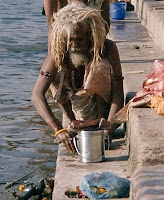 At one of the backpacker places that I stayed at in Zambia, there was a note on the wall. It said that a woman in a village is willing to have guests overnight at her homestead for a small fee. It required a 2 hour minivan bus ride and about a mile walk from the bus drop off point. I decided to grab my bag and give it a try.
At one of the backpacker places that I stayed at in Zambia, there was a note on the wall. It said that a woman in a village is willing to have guests overnight at her homestead for a small fee. It required a 2 hour minivan bus ride and about a mile walk from the bus drop off point. I decided to grab my bag and give it a try.My daytime visit with this woman and her daughter turned out to be fantastic. I would have to use a different word to describe the nighttime.
After dinner I went to the hut that was reserved just for me. It is the hut that you see in the picture above. The walls were made of mud and the roof was thatched. Inside there was a bed and a small nightstand. That was all the hut could fit. There was no electricity inside, but that was to be expected. I usually had a candle in my bag for just this type of situation. All in all I felt very comfortable in this hut. I had no problem falling asleep.
During the night I felt something hit my chest. It wasn't hard but it was hard enough to wake me up. I was about to go back to sleep when I came to my senses. Of course I had to find out what it was. Maybe someone was in my hut? There was definitely an uninvited nighttime visitor in my hut. I heard something moving around. It did not sound like a person. At that point I thought it might be a rooster. Maybe a rooster got into my hut and was jumping around. If this were the case, I'd have to keep my wits about me. I frantically searched for my flashlight. The longer I sat in the dark, the more scared I became of what I might find. I turned on the light and saw a huge guinea pig sized rat run up the wall of the hut and into the thatched roof above me. The rat must have initially either jumped or fallen from the roof. It hit my chest. I moved and the rat ran off me.
Of course now I could not sleep. I was hoping it was 6 a.m. and time to get up. I took a look at my watch. It read 2:30 a.m. Darn it! Now what was I going to do? It was too late in the night for me to sit outside and too early to expect my host to be up. The one thing I knew for sure was that I did not want the rat to touch me. When I was in Lesothos, a man showed me his marked up hand. He told me that a rat bit him while he was sleeping. I definitely knew this was a possibility. I decided to slide all the way down into my sleeping bag and completely close the top where my head normally was. My sleeping bag was a very good quality North Face down bag. In other words, it's great for the mountains but can be quite hot otherwise. I started to sweat. I also was not getting enough air. My face was buried inside the bag. I did not know how I was going to make it until morning. I lay there and sweated for an hour. Occasionally I had to let a small amount of cool air in. Eventually I fell asleep.
I woke at 6:30 a.m. I had survived the night. I do not think I could do another night like that one.







 Probably the most famous building in Petra is the treasury. It became well known after appearing in one of the Indiana Jones movies. Since I have never seen an Indiana Jones movie, I did not know this until I visited and was told that the treasury was especially famous. In order to take the picture to the right, I had to hike up to the top of the gorge. I started to get nervous because I wasn't sure I could find my way down. I had been walking on top for a while and I got turned around. Remember, the city was basically deserted. Fortunately a small group of American men appeared. They were smart enough to go up top with a guide. I attached myself to their group and we climbed down together.
Probably the most famous building in Petra is the treasury. It became well known after appearing in one of the Indiana Jones movies. Since I have never seen an Indiana Jones movie, I did not know this until I visited and was told that the treasury was especially famous. In order to take the picture to the right, I had to hike up to the top of the gorge. I started to get nervous because I wasn't sure I could find my way down. I had been walking on top for a while and I got turned around. Remember, the city was basically deserted. Fortunately a small group of American men appeared. They were smart enough to go up top with a guide. I attached myself to their group and we climbed down together.































